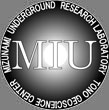Data regarding the geological environment is acquired for various geoscientific fields parallel to the gallery excavations. Horizontal galleries(Sub Stages) have been constructed from the Main Stage for detailed geoscientific study at locations where important features such as permeable fractures and fracture zones and redox fronts are observed. The accuracy of the facility-scale models constructed in Phase I can be evaluated by comparison with actual conditions and the effectiveness of analytical methods used to develop the models will be assessed. Also changes to the deep geological environment in response to excavation can be observed, monitored and assessed. Then models at gallery-scale will be constructed using new data. The geological characteristics in the vicinity of the galleries will be estimated and expanded on in Phase III.
As well, the effectiveness of the existing engineering technologies regarding construction, maintenance and management of the research galleries will be evaluated and, to the extent possible and necessary, will be improved.
Phase II goals
- Develop and revise models of geological environment using the investigation results obtained during excavation and determine and assess changes in the geological environment in response to the excavations
- Evaluate the effectiveness of engineering techniques used for construction, maintenance and management of underground facilities
- Establish detailed investigation plans for Phase III
|
The following investigations are ongoing or planned at the MIU Construction Site.
- Geological mapping of the shafts and drift wall
- Measurement of inflow rate during the shaft sinking
- Cross hole hydraulic test on the Water Conducting Feature(WCF)
- Groundwater sampling from the shaft and boreholes around the shaft, and chemical analysis of the water sampled
- Acoustic Emission(AE) measurement and borehole expansion test for excavation disturbed zone (EDZ) investigation
- Hydraulic pressure and hydrochemical monitoring in the boreholes drilled from the surface around the shaft
|

